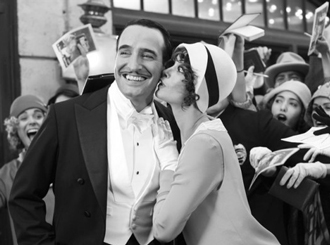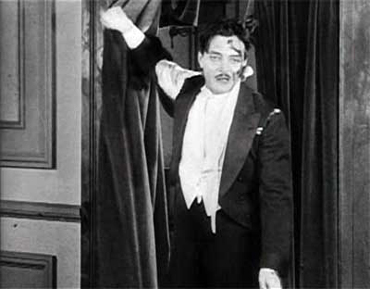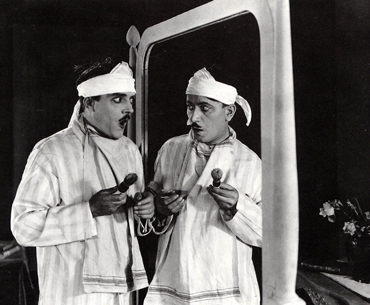
 |
|
|
|
The Academy awarded a Best Picture Oscar to 2011's The Artist, a clever but not exactly earth-shattering foreign comedy that claimed to be a silent movie and starred two talented and photogenic French actors. I was somewhat mystified to hear that people were voting for the show because they loved the dog. To me The Artist was a watered-down version of Singin' in the Rain. 
I'm reminded of that film because its main character, a sometimes-morose silent film star, makes me think that the French filmmakers missed a bet -- they had all the ingredients for a biography about the famous French film comedian Max Linder, who suffered from depression and whose American career had a decidedly un-happy finish. And I don't think anyone would have minded if the filmmakers had sneaked a dog in there too. Kino's new release The Max Linder Slapstick Symposium Collection assembles three features and one shorter comedy by a silent comedian lionized by Charlie Chaplin, although probably when he could no longer offer Chaplin any competition. We're told that Linder's suave, urbane screen character 'Max' was a huge success in France starting back in 1908 or thereabouts. But he never really caught on here, despite appearing in a score of very funny pictures. Linder's 'Max' is an interesting counterpart to Chaplin's Little Tramp persona. A snappy dresser, Max is seldom without his formal attire and top hat. He doesn't push the French oo-la-la stereotype but definitely has an eye for the ladies. Linder's slapstick instincts are highly refined and his screen gags often brilliant in their simplicity. He lacks Chaplin's talent for balletic movement, or Chaplin's flexibility - the Tramp could play various levels of comedy from pixie-like frivolity to mock fury. Max mostly tries to get the girl, avoid unpleasant situations and reach the last scene intact to enjoy a kiss or a wedding ceremony. Linder pictures do not invite speculation about artistic agendas, deeper themes or wider social statement - he's not plagued by armies of cops as is Keaton, and he doesn't suffer from poverty or immigrant issues, as does Chaplin. About as controversial that Max Linder gets is an occasional Prohibition gag -- the man is seemingly never without a hip flask in his coat pocket. Was Linder one comic too many? In 1920 they were already laughing at Chaplin, Arbuckle and Keaton, not to forget Harold Lloyd, a similar 'nice guy' but also a homegrown American and thus more of an identification figure. Linder's pictures are high quality goods and big laugh-getters, but we're told they didn't go over well when new. 
Assembled by Lobster Films, The Max Linder Slapstick Symposium Collection DVD will delight Max Linder newbies while providing a couple of surprises for more seasoned fans. It was. The films are addressed chronologically, leaving the best for last. Max Wants a Divorce is a half-hour comedy from 1917; a note says that it was rescued via an archive in Eastern Europe. It centers on a simple gag that at basis resembles an I Love Lucy episode. Max is newly married (to the ill-fated Martha Mansfield) when he receives a telegram saying that he'll inherit a fortune only if he's a bachelor. The couple then contrives to put max in a compromised position with a woman at a party, so a detective can establish grounds for a quick divorce. But the wife reflexively breaks up this effort. They try it again at an apartment that becomes the new abode of an insane asylum, which leads to various hi-jinks as the detective is presumed to be a patient, etc. Linder's direction is so elegant that we're less aware of the camera than in many pictures of that year - even when he stages some action in stylized silhouettes. Linder's acting may have fallen out of favor, but he could very well have found success as a non-performing director. 
Be My Wife (57 min.) is a domestic sex comedy, which in 1921 means that it's about husbands and wives merely suspecting each other of having love affairs. Max vies for the affections of Mary (Alta Allen), whose annoying Aunt Agatha (Caroline Rankin) prefers a dull, overweight alternative suitor. Banned from the house, Max uses various tricks to stay close to Mary, including masquerading as a scarecrow. But the other fellow's dog keeps getting in the way. Max finally weds Mary by besting a non-existent burglar in a complicated fight that presents a really nice collection of gags. At the wedding party, the defeated fat guy puts a mouse in Max's suit as he dances, a gag that would be further elaborated by Harold Lloyd in The Freshman. The last part of the show takes place in a speakeasy rigged with sliding panels and furniture, to allow it to transform into a fashion salon when the police come to call. Through a series of switcheroos surely worked out on a chalkboard, Linder weaves together several conflicts at once -- the cops looking for the grog shop, Max trying to catch the louse wrecking his marriage, Mary inadvertently thinking the worst of Max, and another couple falling into the same trap of suspected adultery. Linder tops it off with gags about candles getting so hot that they droop to one side, like... candles that got too hot. According to web reports, this restoration is the first complete video presentation of Be My Wife. 
We're told that Seven Years Bad Luck has become Max Linder's most popular picture. It features a crazy progression of major gag sequences that literally seem to have been invented on the fly. First up is an extended mirror gag, that precedes and bests similar scene in later comedies, such as the Marx Bros.' Duck Soup. This gag sequence is likely the main source of Linder's lofty reputation. With his engagement broken and mended several times in quick succession (an impromptu 'tropical' dance in the parlor is marvelous) Max takes a train ride with no ticket or money. Various blackface gags ensue, before he eludes the cops by impersonating a stationmaster. Just when we think that the stationmaster's daughter will be Max's new romantic interest, he gets glue on his hand and accidentally rips her dress off. The absurd plot then sees Max moving in with the lions in a zoo as another way of dodging the cops. The movie never slows down, Max Linder's direction is flawless and the print also looks terrific. We see Glendale's train station 23 years before Barbara Stanwyck and Fred MacMurray pulled off a murder there, and the rich hero's house appears to be at the foot of the Hollywood Hills. 
Billed first on the disc but chronologically made last is a bright and sharp restoration of 1922's The Three Must-Get-Theres a marvelous and still-hilarious takeoff on The Three Musketeers, specifically, Douglas Fairbank's enormously successful feature adaptation from the year before. The all-out spoof substitutes slapstick for dazzling stunts, although Linder does turn out to be no slouch in the action department. Most of the jokes haven't dated in this arched-eyebrow, wink-wink poke at Dumas adventure tales and period pictures in general. It's the standard story, with Linder playing 'Knockout' Dart-In-Again (D'Artagnan, get it?). Dart is a "poor but well-dressed" country boy who challenges the King's Guards Walrus, Octopus & Porpoise before aiding them in their swordfights against the soldiers of Li'l Cardinal Richie-Loo (Bull Montana). Dart falls in love with the Queen's maid Constance Bonn-aux-Fieux. She's played by actress Jobyna Ralston, soon to become Harold Lloyd's recurring leading lady. The inter-titles are funny and the actors have a great time with the hammy roles. Caroline Rankin returns to play Queen Anne, whose honor can be saved only if Dart-In-Again races to England to retrieve her "semi-precious jewels". Half the gags are based on anachronisms worthy of Mad Magazine spoofs. Anne's sewing circle momentarily resembles a jazz band. The head of the king's guards is concerned about his troops' mass killings - he might lose his discount at the cremators. The humor is pitched so that a character named "Roquefort", who can be smelled before he is seen, actually works. When things get crazy, a character produces a telephone out of nowhere. Battleships show up in the English Channel and the King and the Cardinal pass the time by playing with a Dreidel. When the King's Guards are called out, they race to their horses by sliding down a fire pole. As we all know, Prohibition cops were a nuisance back in France of the 1600's -- to avoid trouble Dart-In-Again keeps a hip flask handy for a quick snort. Everyone will love the comedy action scenes, which remind us of Richard Lester's take on the Dumas story a full fifty-one years later. Max's Dart-in-Again has some great gags with a (beautifully trained) mule before launching into action set pieces that spoof Douglas Fairbanks' seeming invulnerability. Linder is graceful and athletic and his sword fighting is tops for comic timing. Then there are some outright cartoonish delights, as when Max leaps from the equivalent of a three-story building without ill effect (one shot, no cuts), and lassos an entire gaggle of the Cardinal's troops, ties them to a horse and watches as they're whisked away at a gallop. It looks like Linder hired professional circus acrobats for a couple of wide-screen gags, which are also a refreshing surprise. Surrounded at sword's point by twenty enemy soldiers, Linder figures out a perfectly logical way to escape. The movie is a great riff on Douglas Fairbanks impossibilities.
Each show features a music track specially scored or arranged by a major talent familiar to fans of silent movies on disc: Maud Nelissen, Eric Le Guen, Robert Israel and Donald Sosin.
On a scale of Excellent, Good, Fair, and Poor,
The Max Linder Slapstick Symposium Collection DVD rates:

Reviews on the Savant main site have additional credits information and are often updated and annotated with reader input and graphics. T'was Ever Thus.
Review Staff | About DVD Talk | Newsletter Subscribe | Join DVD Talk Forum |
| ||||||||||||||||||